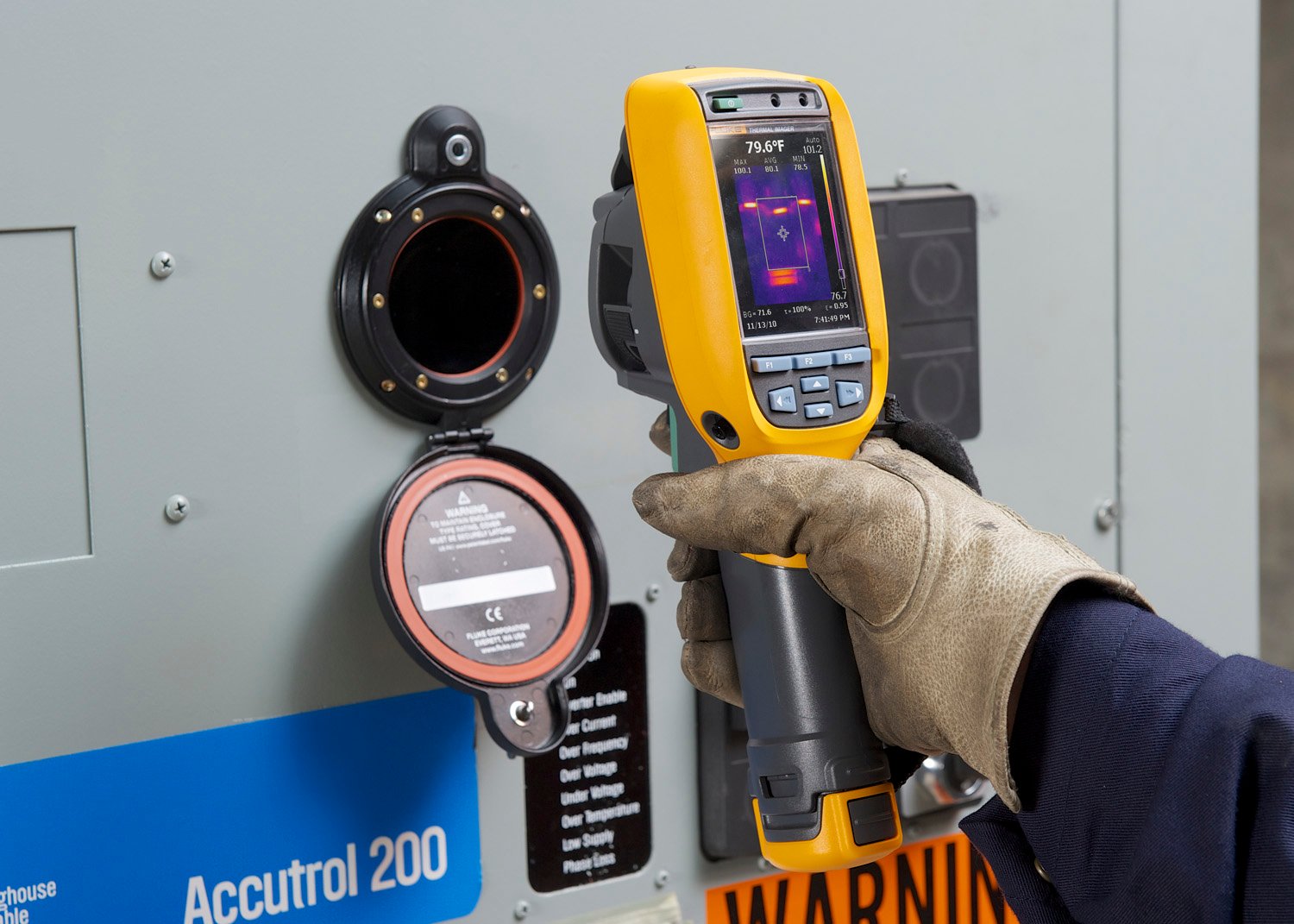Limiting workers’ exposure to electrical hazards like arc flash or electrocution is a solid foundation for any electrical safety program. Combine that mindset with the right non-contact tools and more electrical workers will be kept out of harm’s way.
 Staying clear of danger using a thermal camera to take measurements.
Staying clear of danger using a thermal camera to take measurements.Any time workers are exposed to electrical hazards they are required to establish arc flash boundaries and wear the appropriate arc-rated clothing and rubber insulating gloves. Safely reducing the amount of PPE worn and limiting the amount of time workers spend inside the boundary are some of the major safety advantages of non-contact measurements.
1. Fluke PQ400 Electrical Measurement Window
Electrical measurement windows are permanently installed into a cabinet with voltage and current connections made inside the panel. The PQ400 gives workers access to critical power quality and energy data while decreasing testing time and maintaining a high level of safety. You can plug your power quality tools directly into an electrical measurement window to collect the data needed.
- Reduce the risk of arc-flash and electrocution
- Decrease maintenance costs and reduce downtime by making critical power quality and energy measurements without opening the panel door
- Enabling logging and monitoring at any time—without disrupting operations
- Increase measurement efficiency and reduce the need for full arc-flash PPE
2. Fluke CV400 ClirVu® 4in window
Infrared windows are a permanent fixture that gives a view of what’s on the other side of a panel without exposing workers to live voltage or needing full PPE. Workers can save time and effort while increasing efficiency with the CV400 ClirVu® 4in window. The widest Fluke window option available offers the most visibility into a panel for your thermal camera, simplifying the inspection process:
- PPE needed significantly reduced with fewer work permit requirements
- Reduce time and cost of preventive maintenance
- Faster and more comfortable preventive maintenance inspections
- Reduced risk of arc-flash and electrocution
- Increased the safety of your personnel
 Read measurements without having to open a cabinet.
Read measurements without having to open a cabinet.3. Fluke TiS60+ Thermal Camera
A lot of troubleshooting and preventive maintenance can be started with a thermal camera. Get a temperature reading on your equipment without making physical contact, through an IR window or not, so you can know what’s running too hot, or too cold, before anything breaks down.
The Fluke TiS60+ is a great thermal camera option to capture and measure the heat energy emanating from a source. It offers useful features:
- Compare changes thermal scans over time with Fluke Connect
- Reduce time and cost of preventive maintenance with faster inspections
- One-handed image capture, review and save capability
Keeping other infrared measurement products on hand can also help you keep a safe distance from the arc flash boundary.
- IR thermometers offer a temperature measurement from a distance using a laser beam to aim at the area to be measured. When it comes to safety, grabbing an IR thermometer can mean avoiding climbing up ladders or reaching around rotary shafts to check for hot spots.
- Visual IR thermometer blends a visual image with an infrared heat map overlay.
4. Fluke 376 FC Clamp Meter
Wireless tools, like the 376 FC clamp meter, let you set up the measurement and transmit the data from inside the arc flash boundary. Someone within 20 m of the equipment can then open the Fluke Connect app and see the measurement from outside the boundary.
The 376 FC clamp meter lets you:
- Monitor the measurement safely from outside the arc flash boundary
- Increase safety and decrease the time technicians spend in the arc flash boundary
- Remotely log, trend and monitor measurements to pinpoint intermittent faults
- Inrush measurement to filter out noise and capture motor starting current
5. Fluke 233 Remote Display Digital Multimeter
Remote display tools have a detachable display so the measurements can be read and marked down outside of the arc flash boundary, similar to wireless tools. The Fluke 233 remote display digital multimeter:
- Cuts down on the time technicians spend inside the arc flash boundary
- Easy to read display with large digits and bright backlight
- Can also be used as a conventional meter